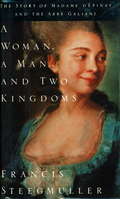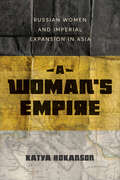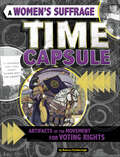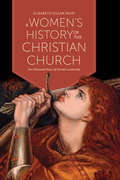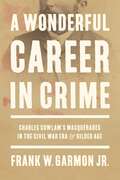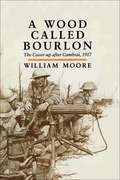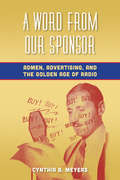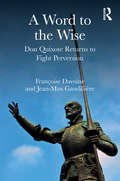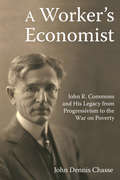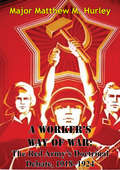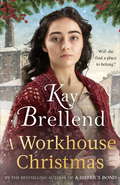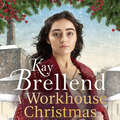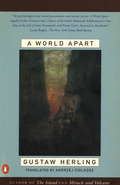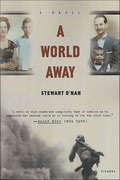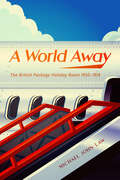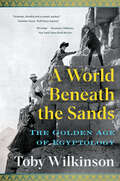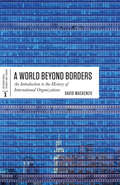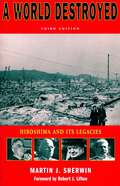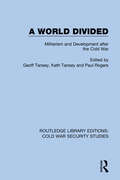- Table View
- List View
A Woman, a Man, and Two Kingdoms
by Francis SteegmullerThe story of the friendship between Madame d'Epinay, a high-spirited intelligent Frenchwoman, and the Abbe Galiani, a diminutive and brilliant Neapolitan, this book presents a portrait of a golden age in European history.
A Woman’s Empire: Russian Women and Imperial Expansion in Asia
by Katya HokansonA Woman’s Empire explores a new dimension of Russian imperialism: women actively engaged in the process of late imperial expansion. The book investigates how women writers, travellers, and scientists who journeyed to and beyond Central Asia participated in Russia’s "civilizing" and colonizing mission, utilizing newly found educational opportunities while navigating powerful discourses of femininity as well as male-dominated science. Katya Hokanson shows how these Russian women resisted domestic roles in a variety of ways. The women writers include a governor general’s wife, a fiction writer who lived in Turkestan, and a famous Theosophist, among others. They make clear the perspectives of the ruling class and outline the special role of women as describers and recorders of information about local women, and as builders of "civilized" colonial Russian society with its attendant performances and social events. Although the bulk of the women’s writings, drawings, and photography is primarily noteworthy for its cultural and historical value, A Woman’s Empire demonstrates how the works also add dimension and detail to the story of Russian imperial expansion and illuminates how women encountered, imagined, and depicted Russia’s imperial Other during this period.
A Women's Suffrage Time Capsule: Artifacts of the Movement for Voting Rights
by Rebecca StanboroughRusted slavery chains, politcal cartoons, and a tube of red lipstick . . . how are these three objects related? Along with other artifacts, these items help tell the story of women's suffrage in the United States. In this Time Capsule History book, readers take a closer look at the historic fight by digging into an imaginary time capsule filled with primary sources. Open it up to explore the fight for voting rights!
A Women's Suffrage Time Capsule: Artifacts of the Movement for Voting Rights
by Rebecca StanboroughRusted slavery chains, politcal cartoons, and a tube of red lipstick . . . how are these three objects related? Along with other artifacts, these items help tell the story of women's suffrage in the United States. In this Time Capsule History book, readers take a closer look at the historic fight by digging into an imaginary time capsule filled with primary sources. Open it up to explore the fight for voting rights!
A Women's Suffrage Time Capsule: Artifacts of the Movement for Voting Rights (Time Capsule History)
by Rebecca StanboroughRusted slavery chains, politcal cartoons, and a tube of red lipstick . . . how are these three objects related? Along with other artifacts, these items help tell the story of women's suffrage in the United States. In this Time Capsule History book, readers take a closer look at the historic fight by digging into an imaginary time capsule filled with primary sources. Open it up to explore the fight for voting rights!
A Women’s History of the Christian Church: Two Thousand Years of Female Leadership
by Elizabeth Gillan MuirTracing two thousand years of female leadership, influence, and participation, Elizabeth Gillan Muir examines the various positions women have filled in the church. From the earliest female apostle, and the little known stories of the two Marys – the Virgin Mary and Mary Magdalene – to the enlightened duties espoused by the nun, the abbess, and the anchorite, and the persecutions of female "witches," Muir uncovers the rich and often tumultuous relationship between women and Christianity. Offering broad coverage of both the Catholic and Protestant traditions and extending geographically well beyond North America, A Women’s History of the Christian Church presents a chronological account of how women developed new sects and new churches, such as the Quakers and Christian Science. The book includes a timeline of women in Christian history, over 25 black-and-white illustrations, a glossary, and a list of primary and secondary sources to complement the content in each chapter.
A Wonderful Career in Crime: Charles Cowlam’s Masquerades in the Civil War Era and Gilded Age
by Frank W. Garmon Jr.Charles Cowlam’s career as a convict, spy, detective, congressional candidate, adventurer, and con artist spanned the Civil War, Reconstruction, and Gilded Age. His life touched many of the most prominent figures of the era, including Abraham Lincoln, Jefferson Davis, and Ulysses S. Grant. One contemporary newspaper reported that Cowlam “has as many aliases as there are letters in the alphabet.” He was a chameleon in a world of strangers, and scholars have overlooked him due to his elusive nature. His intrigues reveal how Americans built trust amid the transience and anonymity of the nineteenth century. The stories Cowlam told allowed him to blend in to new surroundings, where he quickly cultivated the connections needed to extract patronage from influential members of American society.Whereas historians of capitalism have uncovered the vulnerabilities of an economic system dependent upon trust and personal relationships, Cowlam’s life exposes the liabilities of a political system constructed on the same foundations. Rather than perpetrating frauds against average citizens, Cowlam reserved his most fantastic schemes for officials in the highest levels of government. He is the only person to receive presidential pardons from both Abraham Lincoln and Jefferson Davis during the Civil War. When the fighting ended, he conned his way into serving as a detective investigating Lincoln’s assassination, later parlaying that experience into positions with the Internal Revenue Service and the British government.Reconstruction offered additional opportunities for Cowlam to repackage his identity. He convinced Ulysses S. Grant to appoint him U.S. marshal and persuaded Republicans in Florida to allow him to run for Congress. After losing the election, Cowlam moved to New York, where he became a serial bigamist and started a fake secret society inspired by the burgeoning Granger movement. When the newspapers exposed his lies, he disappeared and spent the next decade living under an assumed name. He resurfaced in Dayton, Ohio, claiming to be a Union colonel suffering from dementia in an effort to gain admittance into the National Soldiers’ Home. In A Wonderful Career in Crime, Frank W. Garmon Jr. brings Cowlam’s stunning machinations to light for the first time.
A Wood Called Bourlon: The Cover-up after Cambrai, 1917
by William MooreAfter the great victory in the famous tank battle at Cambrai in 1917 the church bells, having been silent for three years, rang out joyously all over Britain But within ten days triumph turned to disaster. How did this hapPen & why?William Moore, a distinguished First World War historian, attempts to explain what went wrong. All the advantages gained were thrown away; thousands of British troops were captured and hundreds of guns were lost. Seventy years after these events Mr Moore has studied the evidence (much of it previously unpublished) contained in the inevitable enquiry that followed the disaster and he seeks to answer a number of questions. Was Field-Marshal Haig really as dour as he has been portrayed or was he a reckless gambler and was General Byng, whose troops and guns were captured, really a brilliant planner or a haughty aristocrat dedicated to proving that cavalry still had a place on the battlefield? And why were they both obsessed with capturing Bourlon Ridge on which stood the sinister Bourlon Wood? A Highland Division, a Welsh Brigade, a Yorkshire Division (twice), the Guards, Ulstermen, Lancashire-men, Londoners and Midlanders- all were drawn into the maelstrom in an attempt to consolidate the Cambrai victory They failed. It was left to the Canadians to carry the Bourlon position in one of the finest feats of arms of the Great War. The British are always reputed to take a perverce interest in their own military blunders. This strange episode is one that most people have been happy to forget. All those involved in hight places sought to make excuses; some indulged in a profound exercise of duplicity implying that the soldiers themselves were to blame. Mr Moor's book throws new light on a dark episode in British Military History.
A Word for Nature
by Robert L. DormanThe careers and ideas of four figures of monumental importance in the history of American conservation--George Perkins Marsh, Henry David Thoreau, John Muir, and John Wesley Powell--are explored in A Word for Nature. Robert Dorman offers lively portraits of each of these early environmental advocates, who witnessed firsthand the impact of economic expansion and industrial revolution on fragile landscapes from the forests of New England to the mountains of the West. By examining the nineteenth-century world in which the fourmen lived--its society, economy, politics, and culture--Dormansheds light on the roots of American environmentalism. Heprovides an overview of the early decades of both resourceconservation and wilderness preservation, discussing how Marsh, Thoreau, Muir, and Powell helped define the issues that began changing the nation's attitudes toward its environment by the early twentieth century. Dorman's readings of works including Marsh's Man and Nature, Thoreau's The Maine Woods, Muir's The Mountains of California, and Powell's Report on the Lands of the Arid Region reveal their authors' influence on environmental thought and politics even up to the present day.
A Word from Our Sponsor: Admen, Advertising, and the Golden Age of Radio
by Cynthia B. MeyersDuring the “golden age” of radio, from roughly the late 1920s until the late 1940s, advertising agencies were arguably the most important sources of radio entertainment. Most nationally broadcast programs on network radio were created, produced, written, and/or managed by advertising agencies: for example, J. Walter Thompson produced “Kraft Music Hall” for Kraft; Benton & Bowles oversaw “Show Boat” for Maxwell House Coffee; and Young & Rubicam managed “Town Hall Tonight” with comedian Fred Allen for Bristol-Myers. Yet this fact has disappeared from popular memory and receives little attention from media scholars and historians. By repositioning the advertising industry as a central agent in the development of broadcasting, author Cynthia B. Meyers challenges conventional views about the role of advertising in culture, the integration of media industries, and the role of commercialism in broadcasting history.Based largely on archival materials, A Word from Our Sponsor mines agency records from the J. Walter Thompson papers at Duke University, which include staff meeting transcriptions, memos, and account histories; agency records of BBDO, Benton & Bowles, Young & Rubicam, and N. W. Ayer; contemporaneous trade publications; and the voluminous correspondence between NBC and agency executives in the NBC Records at the Wisconsin Historical Society. Mediating between audiences’ desire for entertainment and advertisers’ desire for sales, admen combined “showmanship” with “salesmanship” to produce a uniquely American form of commercial culture. In recounting the history of this form, Meyers enriches and corrects our understanding not only of broadcasting history but also of advertising history, business history, and American cultural history from the 1920s to the 1940s.
A Word on Words: The Best of John Seigenthaler's Interviews
by Pat Conroy Alice Randall Kinky Friedman David Halberstam Doris Kearns Goodwin David Maraniss Jon Meacham Marshall Chapman John Lewis Ann Patchett William Marshall John Egerton Nikki Giovanni Arna Bontemps William Price Fox Waylon Jennings Rodney Crowell Marty Stuart Dori Sanders Charles Fountain Jesse Hill Ford John Michael SeigenthalerFor years the legendary John Seigenthaler hosted A Word on Words on Nashville's public television station, WNPT. During the show&’s four-decade run (1972 to 2013), he interviewed some of the most interesting and most important writers of our time. These in-depth exchanges revealed much about the writers who appeared on his show and gave a glimpse into their creative processes. Seigenthaler was a deeply engaged reader and a generous interviewer, a true craftsman. Frye Gaillard and Pat Toomay have collected and transcribed some of the iconic interactions from the show. Featuring interviews with: Arna Bontemps • Marshall Chapman • Pat Conroy • Rodney Crowell • John Egerton • Jesse Hill Ford • Charles Fountain • William Price Fox • Kinky Friedman • Frye Gaillard • Nikki Giovanni • Doris Kearns Goodwin • David Halberstam • Waylon Jennings • John Lewis • David Maraniss • William Marshall • Jon Meacham • Ann Patchett • Alice Randall • Dori Sanders • John Seigenthaler Sr. • Marty Stuart • Pat Toomay
A Word to the Wise: Don Quixote Returns to Fight Perversion
by Françoise Davoine Jean-Max GaudillièreAfter giving us a fascinating reading of Cervantes' classic novel in Don Quixote: Fighting Melancholia, Françoise Davoine and Jean-Max Gaudillière co-author a second work, to reflect on the hero's battle against perversion. To do so, they retrace his adventures in the Cervantes' second Don Quixote, written ten years after the first. The authors follow in his footsteps as he embarks on this other extraordinary journey in which perversion is laid bare for all to see, creating not only a powerful social link, but even a form of government. Cervantes shows us how madness acts as a means to confront it: here again, the field of action presented to the reader is explored in rigorous detail. The reliability of this strategy derives from the power of the given word, which has to oppose lies, seduction, secrets, trickery and crime, in order to confer authenticity to what madness reveals.
A Worker's Economist: John R. Commons and His Legacy from Progressivism to the War on Poverty
by John Dennis ChasseJohn R. Commons is one of the few reformers of the past century whose major works are still actively read, whose ideas are still debated, and whose principles are still applied to the analysis of contemporary problems. His life spanned the years of America’s “Great Transformation,” from a nation of shopkeepers, farmers, and small towns to one of giant corporations, landless laborers, and crowded cities. He became involved in almost every aspect of America’s response to the damaging side effects of that transformation. A Worker’s Economist begins with John Commons’ childhood and education and continues through his life as a scholar, teacher, administrator, and reformer. Commons’ list of accomplishments are great in number and overall effect. He worked on the staff of the first government commission to investigate the economic and social consequences of corporate mergers. He served as a public representative on the commission that investigated industrial violence and workplace relations. He was a participant observer in America’s largest and most historic mineworkers’ strike. He wrote and administered the nation’s first constitutional worker compensation law. He developed principles of social reform and public administration that his students carried into the design and administration of the Social Security system as well as Lyndon B. Johnson’s War on Poverty. John Dennis Chasse reviews Commons’ major works, describes the people with whom he worked, and follows the fortunes of the unions that were intrinsic to his vision of “collective democracy.” As a final testament to Commons’ importance, Chasse considers his legacy as it endures in the work of his students and beyond.
A Worker’s Way Of War: The Red Army’s Doctrinal Debate, 1918–1924
by Major Matthew M. HurleyFollowing the October 1917 Revolution, the leaders of the fledgling Red Army embarked on a debate concerning the nature, form, and function of military doctrine. A group known as the 'military communists,' including M.V. Frunze, M.N. Tukhachevsky, K. Voroshilov, and S.I. Gusev sought to formulate a 'proletarian' military doctrine based on the lessons of the Russian Civil War (1918-21) and purged of supposedly outmoded, bourgeois military thought. Their doctrine, they claimed, would be based overwhelmingly on maneuver and the offensive, which they felt best represented the 'active' nature of the working class. Against them stood Commissar for War Leon Trotsky, supported by ex-Tsarist military specialists, notably A.A. Svechin. Trotsky and his allies, noting the Soviet Union's backwardness relative to the West, professed a policy of expediency in military affairs. Though Trotsky and Svechin proved their position correct both in reference to military affairs and orthodox communist thought, the ripening political struggle eventually secured Frunze's and Tukhachevsky's domination of the Red Army and Trotsky's eventual ouster and exile.
A Workhouse Christmas: a perfect, heartwarming Christmas saga
by Kay BrellendDiscover the Workhouse to War trilogy by Kay Brellend: a new saga series set in the Whitechapel Union workhouse in East London, between 1904 and 1916. . .Christmas Eve, 1909. Eleven-year-old Lily Larkin is left to fend for herself in an East London workhouse after her dying mother is taken to an infirmary: her future looks bleak. Once she is separated from her twin brother, Davy, her childhood hopes seem to shatter. But Lily's fierce spirit - along with her beloved new friends - help her to endure the miserable drudgery of life at South Grove Workhouse and its cruel supervisor, Miss Fox.When a handsome, smartly-dressed gentleman shows up at the workhouse, claiming to be her cousin and with an offer of employment, Lily seizes her chance to escape. But her new job is far from perfect, and her reunion with her brother isn't what she thought it would be. Still, she relishes her freedom from the workhouse, and, finding herself on the cusp of womanhood, is determined to embrace her new life - until a shocking secret from her past is uncovered. As everything she'd ever believed about herself is thrown into confusion, will Lily ever be able to rise above her past?Praise for Kay Brellend'Vividly rendered' Historical Novel Society'A fantastic cast of characters' Goodreads'Thoroughly absorbing' Goodreads
A Workhouse Christmas: a perfect, heartwarming Christmas saga (Workhouse to War)
by Kay BrellendDiscover the Workhouse to War trilogy by Kay Brellend: a new saga series set in the Whitechapel Union workhouse in East London, between 1904 and 1916. . .Christmas Eve, 1909. Eleven-year-old Lily Larkin is left to fend for herself in an East London workhouse after her dying mother is taken to an infirmary: her future looks bleak. Once she is separated from her twin brother, Davy, her childhood hopes seem to shatter. But Lily's fierce spirit - along with her beloved new friends - help her to endure the miserable drudgery of life at South Grove Workhouse and its cruel supervisor, Miss Fox.When a handsome, smartly-dressed gentleman shows up at the workhouse, claiming to be her cousin and with an offer of employment, Lily seizes her chance to escape. But her new job is far from perfect, and her reunion with her brother isn't what she thought it would be. Still, she relishes her freedom from the workhouse, and, finding herself on the cusp of womanhood, is determined to embrace her new life - until a shocking secret from her past is uncovered. As everything she'd ever believed about herself is thrown into confusion, will Lily ever be able to rise above her past?Praise for Kay Brellend'Vividly rendered' Historical Novel Society'A fantastic cast of characters' Goodreads'Thoroughly absorbing' Goodreads
A Workhouse Christmas: a perfect, heartwarming Christmas saga (Workhouse to War)
by Kay BrellendDiscover the Workhouse to War trilogy by Kay Brellend: a new saga series set in the Whitechapel Union workhouse in East London, between 1904 and 1916. . . Christmas Eve, 1909. Eleven-year-old Lily Larkin is left to fend for herself in an East London workhouse after her dying mother is taken to an infirmary: her future looks bleak. Once she is separated from her twin brother, Davy, her childhood hopes seem to shatter. But Lily's fierce spirit - along with her beloved new friends - help her to endure the miserable drudgery of life at South Grove Workhouse and its cruel supervisor, Miss Fox.When a handsome, smartly-dressed gentleman shows up at the workhouse, claiming to be her cousin and with an offer of employment, Lily seizes her chance to escape. But her new job is far from perfect, and her reunion with her brother isn't what she thought it would be. Still, she relishes her freedom from the workhouse, and, finding herself on the cusp of womanhood, is determined to embrace her new life - until a shocking secret from her past is uncovered. As everything she'd ever believed about herself is thrown into confusion, will Lily ever be able to rise above her past?Praise for Kay Brellend'Vividly rendered' Historical Novel Society'A fantastic cast of characters' Goodreads'Thoroughly absorbing' Goodreads
A World Aflame # Interwar Wargame Rules 1918-39
by Mark Stacey Paul EaglestoneOften called the "Pulp Era", the years between the two World Wars have seen a tremendous surge in interest among wargamers. A World Aflame captures the adventurous nature of the time period to present a fun, fast-paced set of tabletop miniatures rules that can handle the many diverse conflicts of the period, from the Chinese Civil Wars and the "Great Game" in Central Asia, to the Irish War of Independence and the bitter ideological warfare of the Russian and Spanish Civil Wars. The rules also contain options for the "Very British Civil War". This gaming trend has sprung up in recent years, following a "what-if" scenario that has Edward VIII refusing to abdicate the throne, thrusting the country into civil war in 1938. It is a quirky, fun setting, and one that is surprisingly popular. Written by a life-long wargamer, A World Aflame focuses on the daring and heroism of battles fought in the last great era of adventure.
A World Apart: Imprisonment in a Soviet Labor Camp During World War II
by Bertrand Russell Gustaw Herling Andrzej CiolkoszIn 1940, Gustav Herling was arrested after he joined an underground Polish army that fell into Russian hands. He was sent to a northern Russian labour camp, where he spent the two most horrible years of his life. In this book, he tells of the people he was imprisoned with, the hardships they endured, and the indomitable spirit and will that allowed them to survive. Above all, he creates a portrait of how people - deprived of food, clothing, proper medical care, and forced to work at hard labour - can come together to form a community that offers hope in the face of hopelessness, that offers life when even the living have no life left.
A World Away: A Novel
by Stewart O'NanThe acclaimed author delivers an “affecting and nuanced examination of family alliances tested by infidelity, illness and the pervasive impact of WWII” (Publishers Weekly).Set at a remote beachfront cottage in the Hamptons one summer during the Second World War, A World Away follows the fortunes of the Langer family, whose oldest son, Rennie, is missing in action in the Pacific theater. But there is another battle raging at home, as Anne and James Langer’s marriage begins to unravel. After her husband’s affair with a student, Anne begins a clandestine romance with a soldier stationed at a nearby base. Yet all the passion and tenderness Anne finds with her lover is unable to ease the ache of her family being torn apart.Thousands of miles away, Rennie is wounded in the effort to drive the Japanese from the island of Attu, as his young wife gives birth alone in San Diego. When Rennie comes home, James and Anne must repair their own broken lives if they’re going to help their son heal. A World Away is a rich, romantic story that has all the depth and generosity of spirit that have become Stewart O’Nan’s signature.
A World Away: The British Package Holiday Boom, 1950–1974
by Michael John LawThe 1950s and 1960s were a transformative period in Britain, and an important part of this was how Britons’ lives were changed when they began flying abroad for their holidays. In A World Away Michael John Law investigates how something that previously only the rich could afford became available to working-class holidaymakers.A World Away moves beyond the big players in the tourist industry and technical accounts of the airplanes used by tour operators to tell the histories of the people who were there, both tourists and tour guides, using their personal testimonies. Until now there has been uncertainty about the identity of these new tourists: some feared they were working-class intruders who might invade the pristine destinations favoured by the elite; others claimed that most were from the middle class. Using new data derived from flight accident investigations, Law explains the complex origins of these new flyers. In British society this unprecedented mobility could not go unpunished, and the new tourists were lampooned in books and newspapers aimed at the middle classes. Law shows how popular culture, movies, and music influenced the decision to travel, and what actually happened when these new holidaymakers went abroad.Law investigates the package tour industry from its mid-century origins through its inherent weaknesses, governmental interference, and unforeseen world events that contributed to its partial failure in the early 1970s. A World Away provides the definitive account of this important change in postwar British society.
A World Beneath the Sands: The Golden Age Of Egyptology
by Toby WilkinsonA thrilling history of the West’s scramble for the riches of ancient Egypt by the foremost Egyptologist of our time. From the decipherment of hieroglyphics in 1822 to the discovery of Tutankhamun’s tomb by Howard Carter and Lord Carnarvon a hundred years later, the uncovering of Egypt’s ancient past took place in an atmosphere of grand adventure and international rivalry. In A World Beneath the Sands, acclaimed Egyptologist Toby Wilkinson chronicles the ruthless race between the British, French, Germans, and Americans to lay claim to its mysteries and treasures. He tells riveting stories of the men and women whose obsession with Egypt’s ancient civilization helped to enrich and transform our understanding of the Nile Valley and its people, and left a lasting impression on Egypt, too. Travelers and treasure-hunters, ethnographers and archaeologists: whatever their motives, whatever their methods, a century of adventure and scholarship revealed a lost world, buried for centuries beneath the sands.
A World Beyond Borders: An Introduction To The History Of International Organizations (International Themes And Issues Ser. #1)
by David MacKenzieThis short and well-written overview provides essential information on the history of international organizations (IOs), with particular focus on the League of Nations, the development of the United Nations, and the UN system. Starting at the beginning of the twentieth century, when there were very few international organizations in existence, A World Beyond Borders traces the growth of IOs through to the close of the century, when there were literally thousands at the heart of the international system. Following this chronological order, the book examines how international organizations became the major legal, moral, and cultural forces that they are today, involved in all aspects of international relations including peacekeeping, disarmament, peace resolution, human rights, diplomacy, and environmentalism. This book is the first in the Canadian Historical Association / University of Toronto Press International Themes and Issues Series, which is dedicated to publishing concise, focused overviews of topics that are of international significance in the study of history.
A World Destroyed: Hiroshima and Its Legacies, Third Edition (Stanford Nuclear Age Series)
by Martin J. SherwinContinuously in demand since its first, prize-winning edition was published in 1975, this is the classic history of the development of the American atomic bomb, the decision to use it against Japan, and the origins of U.S. atomic diplomacy toward the Soviet Union. In his Preface to this new edition, the author describes and evaluates the lengthening trail of new evidence that has come to light concerning these often emotionally debated subjects. The author also invokes his experience as a historical advisor to the controversial, aborted 1995 Enola Gay exhibit at the National Air and Space Museum of the Smithsonian Institution. This leads him to analyze the impact on American democracy of one of the most insidious of the legacies of Hiroshima: the political control of historical interpretation. Reviews of Previous Editions "The quality of Sherwin's research and the strength of his argument are far superior to previous accounts." —New York Times Book Review "Probably the definitive account for a long time to come. . . . Sherwin has tackled some of the critical questions of the Cold War's origins—and has settled them, in my opinion." —Walter LaFeber, Cornell University "One of those rare achievements of conscientious scholarship, a book at once graceful and luminous, yet loyal to its documentation and restrained in its speculations." —Boston Globe
A World Divided: Militarism and Development after the Cold War (Routledge Library Editions: Cold War Security Studies #1)
by Geoff Tansey; Kath Tansey; Paul RogersThis book, first published in 1994, analyses the changing world order at the end of the Cold War. As the East-West military axis was replaced by North-South economic polarization and global insecurity, it became clear that future wars were likely to stem from resource and environmental conflict and from the effects of mass movements of displaced people. Using case studies from around the world, the authors diagnose the problems caused by increasing militarism, and analyse the links between conflict, poverty, development and the environment.
